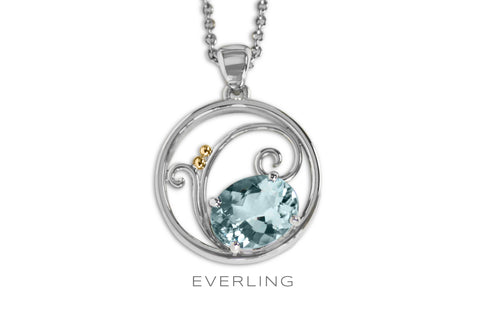We've Got The Mermaid Blues
March is here and that means it is the month of Aquamarine! We find aquamarine to be an incredibly beautiful gem because of its water-like appearance. Literally, the name is derived from the Latin words “aqua” meaning water, and “marina” meaning the sea. Aquamarine is the blue variety of Beryl, the same mineral family as Emerald. Perhaps its most alluring attribute comes not from the gemstone itself, but from the words of the Roman Historian, Pliny, who referenced the gem as, “…seem[ing] to have come from some mermaid’s treasure house, in the depths of a summer sea” (Gems in Myth, Legend and Lore, 51). It is our vision of Mermaids adorned by this water-like treasure, enchanting the depths of the sea, that captivates our imaginations and inspires us to dream.

Respectively, March is also the month of the Pisces, a water sign in the Zodiac, whose symbol is of two fish swirling around one another in a yin-yang fashion. This symbol is indicative of an essential duality, and life’s most fundamental rule: where there’s a beginning, there’s an end, and where there’s an end, there’s a beginning. Likewise, waves along a shore remind us with every breaking wave that there’ll be one more. All of these things tie gracefully together, the water and waves, the mermaids, the fish, and of course, the color blue. Aquamarine is so closely tied to the world’s oceans that in the past sailors would have aquamarine tokens carved with protection symbols and would carry their tokens on voyages to ensure safe passage.
Aquamarine is known for its pale to bright blue color and easy sparkle. But actually, aquamarine is most abundantly found in a green-blue color. Long ago, aquamarines were favored in their greener appearance. These days, however, the stronger blue tends to capture a higher price. For this reason, many aquas are heat treated to enhance the blue tones and diminish green tones.
Three varieties of aqua that are not commonly seen are Cat’s Eye Aquamarines, Star Aquamarines, and Moss Aquamarines. Cat’s eye aquas exhibit a rare phenomenon known as cat's eye chatoyancy. This is where thousands of tiny needle inclusions in the aqua reach the surface and reflect light in such a way that the stone appears to have a cat’s eye-slit. A similar effect to the way a cat’s eye is formed is when those tiny needles form a star. What you’ll see as light hits the stone directly from above is rays of light protruding outward in opposing directions that resemble an asterisk. This is a rare effect in Aqua that is seen more widely in ruby and sapphire. Aquamarines exhibiting this effect are extremely valuable.
Last but not least we have Moss Aquamarines, not to be confused with moss agates. The inclusions that give moss aqua its name, look more like small black inclusions and sometimes dark needle inclusions. Because of this, Moss Aqua is actually considered a low quality aquamarine. But just as salt and pepper diamonds are becoming a trend, so are these aquas. For generations people have deemed included gemstones as poor in quality and, therefore, unpleasant to the eye and unworthy of putting into jewelry. But we believe that inclusions within gemstones are the fingerprints of a gem and an identifying feature. If you look closely enough you will see that inclusions can be absolutely fascinating, and sometimes make a gemstone truly unique.
See them in person
At Everling we love all varieties of Aquamarine. We hope you’ll appreciate this gorgeous gem as much as we do! For inquiries on sourcing or for any other questions please feel free to Contact us!
Custom recycled Platinum and 14k Yellow gold hand fabricated pendant with an oval prong set Aquamarine by Everling Jewelry.
References:
Knuth, B. G. (2007). Gems in myth, legend, and lore. Parachute, CO: Jewelers Press.
